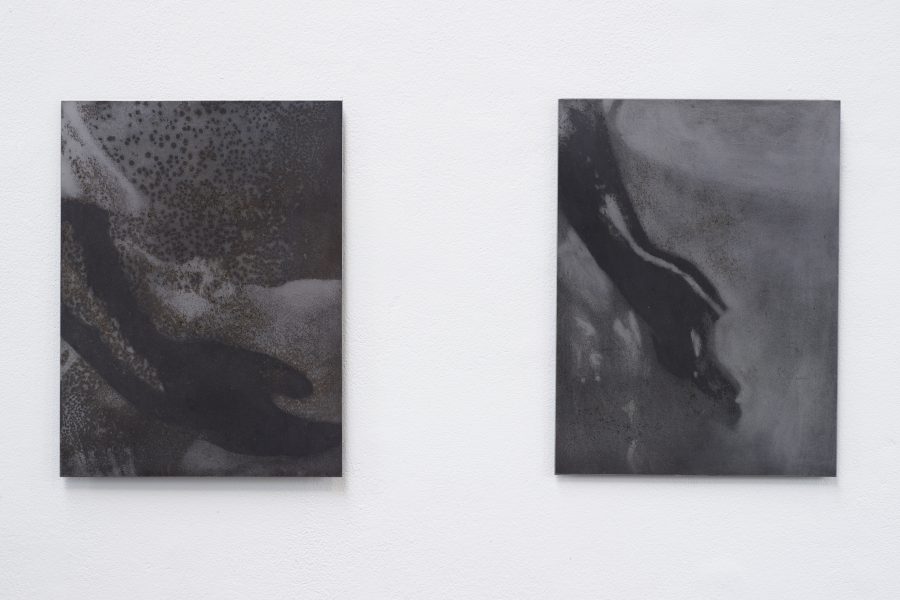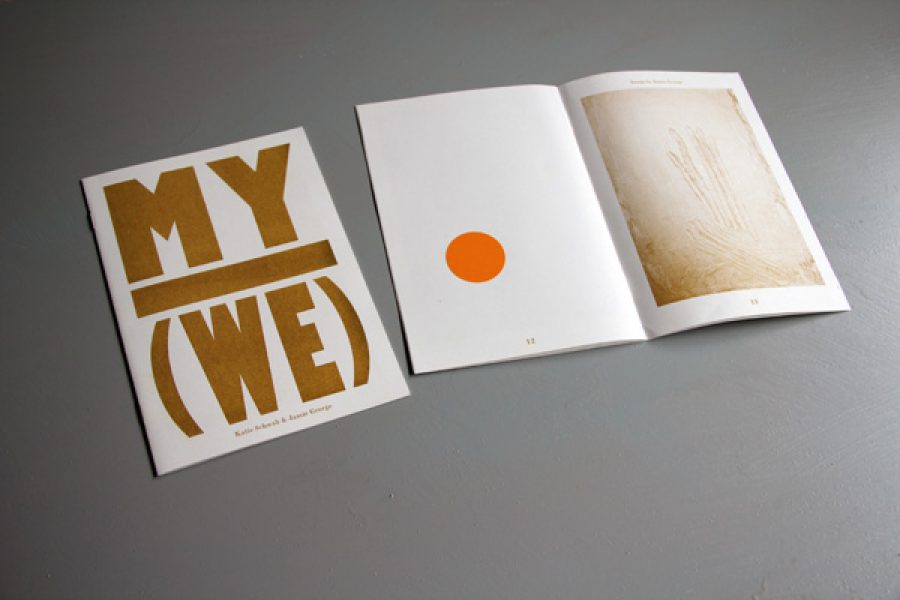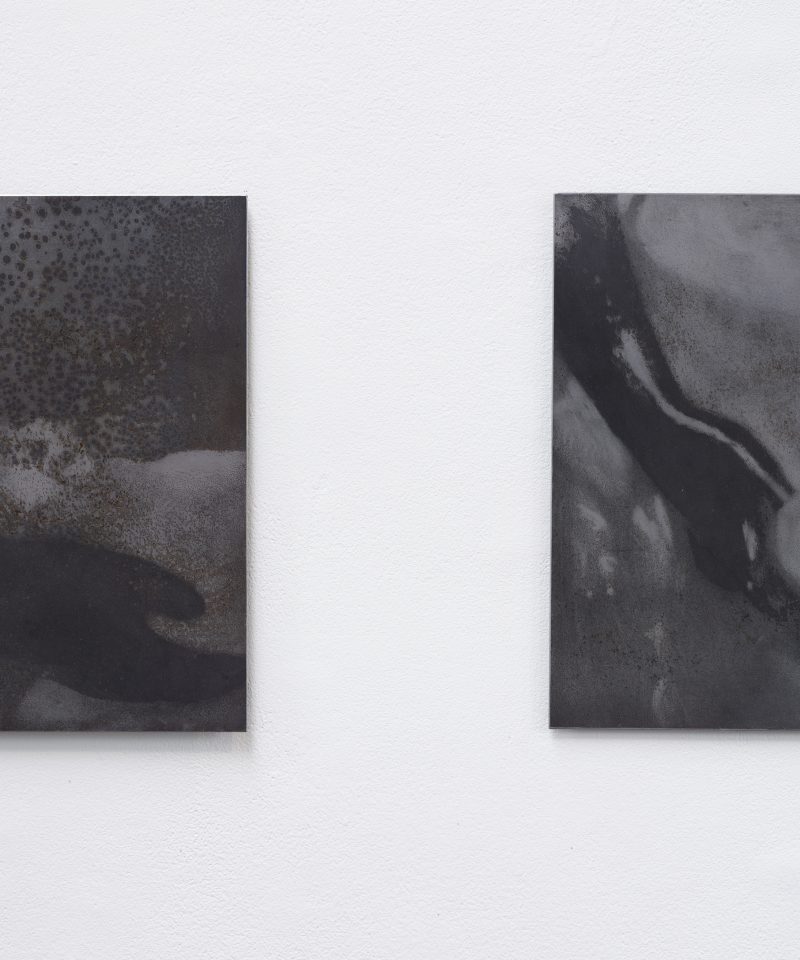“These images visualize a tense grammar of colonization and black self-fashioning, as well as the tense relations of photographic subjects to the ethnographic gazes engendered by the history of colonial dispossession. A complex entanglement of social, historical, political and perhaps most important, visual tensions structures these images’ depiction of their African subjects. They are tensions Frantz Fanon suggested we engage by way of the black body, in particular, through its muscles.”
Tina Campt, Listening to Images (2017, 50)0
I was reminded of the above upon viewing the eight etchings in Holly Graham’s Sweet Swollen. Each sugar-lift tint depicts a different close up viewpoint of a hand. As is explained in the accompanying audio piece, each hand belongs to a porcelain figurine in the Victoria and Albert Museum (V&A) collection. Each of these figurines is unnamed; the V&A catalogue lists them as ‘Figure’. One pair of figures in particular, which is the main focus of Graham’s piece, was mass produced after an original model from 1741. The catalogue entry for the pair lists no title and does not specifically name any person that each figure is modelled after. They are ‘sweetmeat’ bowls. Wealthy 18th century Europeans would have had them on their tables to hold sugary treats that were rising in popularity as sugar, harvested using slave labour, was being imported from the Caribbean. Hence, the porcelain bowls served a practical purpose, to hold candy, and a symbolic purpose, to celebrate the wealth that was being created for Europe by hard labour that they did not pay for.
Each figure is posed beside the bowl and enamelled in jet black with bright red lips, a common colour combination of many an anti-black representational trope. The figures are ornamental, as in they serve no apparent design function on the bowl itself. The two people represented here, who the V&A catalogue entry says are meant to be black Africans, are not fashioned in a way in which their bodies are contorted to form the bowl. They don’t actually hold the bowl, either. Both of them stand next to the bowl, which is white with dainty florals. As I see it, their inclusion beside these bowls primarily was meant to serve the viewing pleasure of its owner. In other words, the total object satisfies two different functions side by side, literally. The white bowl for practical function and its accompanying black figure for symbolic function.
The poses into which each figure is arranged may have, at one point, had meaning. When I tried to position my own body into each pose, it was uncomfortable and painful to hold for more than a few seconds. Graham chose not to engage with the whole of each pose, but rather focused solely on the hands.
Standing in Graham’s Sweet Swollen exhibition in the Project Space, looking at this tight display of eight hands, I thought – this must be what Tina Campt, quoted above, meant. In her most recent book Listening to Images, she laid out her methodology of engaging with ‘quiet’ representations of the African diaspora that resonate at ‘lower frequencies’ and ‘at the level of the quotidian’ (Campt, 2017, 7). Campt employs this by seeking out imagery that ranges from mandatory state surveillance (prison photos) to ethnographic photography to Tumblr photos. What recurs for Campt is the necessity of engaging with imagery that is ‘troubling’ (2017, 42) or ‘vexing’ (2017, 49), and to, albeit with difficulty, read what else these sitters, whether voluntary or compelled, might be saying at a quieter frequency beyond the immediacy of the visual. What is being sounded in these images is quiet refusal and fugivity (Campt, 2017; see also Hartman 2007; Moten 2009; Moten and Harney 2013).
In her analysis of a set of ethnographic photographs taken by Trappist missionaries in southern Africa, Campt recalls Fanon to suggest that one can begin to find these quiet acts of refusal by paying particular attention to muscular tension.
“We must attend to the muscular tensions imaged in these portraits as a performance of stillness that holds the complex forces that surrounded and produced these images temporarily at bay or in equilibrium” (Campt, 2017, 52).
And so when Graham presented these sugar-lift tints, these enlarged reproductions of the hands of these porcelain figures, I thought, is this what it means to listen to images?
Each hand is static, extended indefinitely, in an unsustainable and thus unfeasible pose. One figure, which V&A describes as ‘being in the form of a black woman’ (my emphasis) is jet-black, bare breasted, docile, leaning inward but not forward, holding a bright yellow lemon. For Graham to, amidst all that, isolate this form’s hands is, I would argue, an act of deep, deep listening.
I thought that I was going to make a comparative analysis between Graham’s figure-hands and the hands of Campt’s own listening, particularly the latter’s delicate analysis of hands during her trip to view an archive of mugshots from South Africa’s Breakwater Prison. However, I quickly became most enthralled by a potentially grave shortcoming of my own planned methodology.
The medium analysed throughout Listening to Images is photography. The photographs of black subjects were certainly filtered through the camera person’s imagination and intention. Perhaps there would be no photograph at all if not for the desires of the camera person. In the case of the Trappist mission, photographs were used to fundraise for the continuing of the colonial mission (2017, 50-53). Thus the desire that begat the colonial photographs that Campt references were in fact a multilayered series of desires: ideological, prurient and capitalistic. It is here that I am stopped in my own intended tracks. For all this driving desire to capture, which seems similar and related to the desires that informed the V&A ‘Figures’, for the colonial photographs there was still a human sitter. A living, breathing Black subject, after the moment of objectification and capture, relaxed out of their tense refusal. Or, more than likely, they moved into a new, distinct, subsequent moment of tension and object-capture, but nonetheless continued to move through the world. Whatever moment of objecthood the black people in the images that Campt listened to may have inhabited was at the behest of a complex set of forces, but it was not absolute. What troubles me about then bringing Campt’s analysis into conversation with Holly’s treatment of the Figures is that I cannot locate a possible subjecthood (and thus agency, fugivity) for the porcelain objects.
These Figures are commercially reproduced porcelain objects with an original model sculpted by a named artist. Would the original clay model have even had a human sitter, a model, a muse? Would that human sitter for the jet-black, lemon-holding figure have been an African woman? Ultimately, to make a porcelain figure in the form of a black woman does not necessarily require that an actual black woman sit to model for the image to be produced.
‘in the form of’ signals to me that this pair of porcelain objects was intended to, and maybe continues to function as an image. They were reproduced, sold and circulated as an image and as aforementioned, as an image that would signify. Of course, this porcelain figure, modelled in 1741, predates photography and so I’m not questioning this porcelain-image in comparison to photography. Instead, what I mean to question is: given the fact that the technology of distribution (through the mass production of figurines) by which this object was made did not actually require the presence of a black person in the process of the image’s conception – well, simply put: if we listen to this porcelain-object-image, as I’m purporting that Holly has done, what are we actually listening to?
At this point, I’m reminded of Hortense Spillers’ landmark essay “Mama’s Baby, Papa’s Maybe: An American Grammar Book” (1987), specifically a portion of the exact quote that Campt opens her own first chapter with. In her assessment of black female subjectivity, Spillers posits:
“I describe a locus of confounded identities, a meeting ground of investments and privations in the national treasury of rhetorical wealth. My country needs me, and if I were not here, I would have to be invented” (Spillers, 1987, 65).
Ultimately, I would argue that what Holly Graham actually listened to is, in fact, one of these European inventions. The idea that ‘my country needs me’, rings true in these porcelain figures. In fact, the esteem that the porcelain figure afforded the owners of the object, as a status symbol, would imply that Europe needed her, invented her for its own means of self-fashioning. This is the symbolic function that she performs beside the ergonomic function of the sweetmeat bowl. It is this psychological-colonial dynamic to which Graham has listened, and then heard hands.
For me, an integral part of Campt’s listening exercise is the process of hearing and acknowledging the voice of oppressed peoples. The absence of ‘people’, or rather the way that these particular porcelain images are not necessarily of people at all, but rather a projection of colonial desire, troubles the application of Campt’s methodology to this exercise – but it does not ruin it. For me, to continue this analysis would necessitate a discussion of the function of Graham’s isolated aquatint hands, and the accompanying audio piece, as images in their own right. To what extent do they compete with, redeem, counteract the porcelain image? Or to what extent do they have a continuity in some sort of evolutionary sense? Are they completely other, as in – has Graham made an image that has managed to break completely free of its source material?
Bibliography:
Campt, Tina M. Listening to Images. Duke University Press, 2017.
Spillers, Hortense J. “Mama’s Baby, Papa’s Maybe: An American Grammar Book”, s, Diacritics, Vol. 17, No. 2, Culture and Countermemory: The “American” Connection (Summer, 1987), pp. 64-81.



